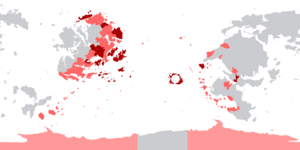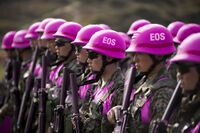Civil Administration of Oriental States
 Flag of the Civil Administration[a] | |
 | |
| Abbreviation | CAOS |
|---|---|
| Named after | Oriental Ocean |
| Motto | Ex Oriente, Scientia |
| Predecessor | Entente of Oriental States |
| Formation | June 2020 |
| Purpose | Economic and Scientific Cooperation |
| Headquarters | Deseti, Orioni |
| Website | www.caos.int |
The Civil Administration of Oriental States (CAOS) is a prominent and independent civilian institution, inaugurated in June 2020. The CAOS is overseen by Administrator Yuto Nakamura from Ide Jima and Deputy Administrator David Smith from Niederoestereich. Its formation was the culmination of a meticulously planned strategic decision by the Entente of Oriental States (EOS) to compartmentalise and refine its non-military functions, thereby enhancing the efficiency and focus of both military and civilian undertakings.[1] This seminal shift was intended not just for organisational restructuring, but also to bolster the potential of initiatives that fell outside the direct purview of defence and security. These initiatives spanned a gamut of domains including administrative management, developmental strategies, and pioneering scientific endeavours. A noteworthy inclusion within CAOS's purview is the esteemed ARTHA participation, which stands as proof of the calibre and ambition of its ventures.
Drawing its name from the majestic Oriental Ocean, CAOS symbolically aligns itself with the vastness, depth, and interconnectedness of this great body of water. Guided by its philosophical and motivational motto “Ex Oriente, Scientia” – translated as “From the East, Knowledge” – CAOS underscores its mission to serve as a beacon of innovation, cooperation, and advancement in both economic and scientific spheres for the region. CAOS is dedicated to leading the member states towards a future marked by scientific discovery, economic integration, and sustainable development. It operates under a strategic plan that includes initiatives like Vision 2025, Oriental Innovation Strategy, and Green Horizon 2030, and backed by a robust annual budget. This ethos not only defines its foundational principles, but also carves out its vision for the future, aspiring to usher in an era of unparalleled growth and collaborative prosperity across the member states.
Member states
The Civil Administration of Oriental States, in line with its sister organisation, the Entente of Oriental States (EOS), encompasses a diverse group of member states. These are unified by their acceptance of the charter and their shared interest in the region’s development and prosperity. Members have full voting rights and the ability to propose resolutions, playing a significant role in shaping the policies and direction of the organisation. Observer states, while not having full membership privileges, are allowed to participate in certain CAOS activities. However, they do not possess voting rights and cannot submit resolutions. This status provides these states with an opportunity to engage with and benefit from the organisation's activities, fostering regional collaboration and understanding. Both members and observers contribute to the vibrant and dynamic nature of CAOS, facilitating a wide-reaching and inclusive approach to regional issues, spanning from economic development to scientific research.
Programmes
The Civil Administration of Oriental States oversees a diverse range of civilian initiatives, designed to foster scientific advancement, promote sustainable development, and ensure efficient administrative operations. These programmes are categorised into three primary divisions: Administration, Science, and Development. Collectively, these divisions encapsulate CAOS's overarching mission and vision. They underscore the organisation's unwavering dedication to bolster scientific research and innovation, champion sustainable growth models, and enhance the seamlessness of its administrative frameworks. Through its multifaceted programmes, CAOS strives to make a tangible impact, enriching the lives of those within its purview and setting the standard for similar organisations wurldwide.
Administration
The Joint Headquarters Facilities represent the nerve centre of the Civil Administration of Oriental States and are strategically situated in Deseti, a prominent location within Orioni. Functioning as the epicentre for all key administrative functions, this establishment plays an indispensable role in ensuring that CAOS's diverse range of activities and operations are coordinated effectively and efficiently.[2]
The facilities are meticulously designed to foster collaboration among different departments, facilitating seamless communication and efficient decision-making processes. Furthermore, the infrastructure of the headquarters is equipped with state-of-the-art technology, ensuring that CAOS remains agile in its responses and can adapt to the evolving needs of the member states.
Beyond its primary operational functions, the Joint Headquarters Facilities also play a symbolic role. As visible proof of CAOS's commitment to administrative excellence, the establishment stands as a beacon, representing the institution's dedication to its mission and serving as a rallying point for its members. Overall, the Joint Headquarters Facilities in Deseti are not just a physical structure but the heart and soul of CAOS's administrative endeavours, driving the organisation forward in its noble pursuits.
Science

The CAOS Space Program, anchored in Arrabar, Tamurin, represents one of the most significant investments by CAOS in the realm of space exploration and research.[3] Under the expert guidance of Tamurine professor Harry Carey, it aims to explore the vast unknowns of the cosmos and understand the intricacies of our universe. Professor Carey's expertise is not confined to the academic realm alone. He is also renowned for bringing scientific knowledge to the broader public through his acclaimed series, Space, The Infinite Frontier.[4] This show has served to inspire a new generation of space enthusiasts and future scientists, bridging the gap between complex space phenomena and the general populace. Satellites from the CAOSSAT program can track fires from space.[5]
The MIDAS Program, short for 'Maritime Information, Detection & Alarm System', is one of CAOS's more ambitious projects, designed to redefine the frontiers of maritime science and technology.[6] With the primary objective of serving as a comprehensive early-warning system, it encompasses various facets from maritime anomaly detection to weather services. Such an initiative reflects CAOS's dedication to harnessing advanced scientific methods for the betterment of its member states and enhancing maritime safety.
The 'Antargic Strategy and 20-Year Action Plan' recognises the pivotal role Antargis plays in global climate systems and its unique biodiversity, CAOS has laid out a detailed strategic framework. This 20-year action plan showcases the organisation's vision for sustainable engagement and research in the Antargic region.[7] Through this, CAOS aims to strike a balance between scientific exploration and environmental conservation, ensuring that the pristine landscapes and ecosystems of the region remain undisturbed for future generations. The CAOS Antargic Territory (CAOSAT) is a sector of Antargis managed by CAOS as an Overseas Condominium.[8]
Development

The CAOS has been deeply involved in a variety of developmental activities, with a particular emphasis on fostering financial collaboration, providing rapid crisis response, and ensuring regional stability through peacekeeping operations.
One of the cornerstones of the developmental efforts by CAOS is the establishment of the CAOS Banking Network in Orthen, Miiros. This network serves a pivotal role in the financial infrastructure of the region by facilitating monetary operations and integration among member states, thus streamlining financial processes and fostering economic unity.[9]
In addition to financial initiatives, CAOS is acutely aware of the pressing need to address crises and disasters. To this end, the Crisis Action & Relief Efforts (CARE) office has been established.[10] This dedicated entity is tasked with providing swift and effective responses to emergencies, ensuring that aid reaches those in need promptly. Some vital activities carried out by CARE include the setting up of distributed aid depots in geopolitically stable partner countries to ensure a rapid response capability. A shining example of CARE's commitment can be seen in its earthquake relief operations in San Agostino, Italgria, where they played a crucial role in alleviating the suffering of affected communities.[11] Further highlighting CARE's dedication to humanitarian aid, in March 2019, it secured an automatic membership with the esteemed International Red Cross of Eurth, aligning itself with global standards of crisis response and relief.
Moreover, regional stability is paramount to the development and prosperity of any region, and CAOS acknowledges this through its Peacekeeping Missions. These missions are backed by the multinational force, commonly referred to as the Pink Helmets, and are committed to maintaining peace in areas rife with conflict. These peacekeepers have been deployed in various crucial missions over the years. A couple of notable instances include their engagement during the 2006 peacekeeping mission in Zekistan, where they played a decisive role in stabilising the situation,[12] and their 2019 deployment in the Bainbridge Islands, again demonstrating CAOS's commitment to peace and regional stability.[13]
Management
Leadership
The role of Administrator in the Civil Administration of Oriental States represents the highest echelon of leadership within this significant intergovernmental organisation. Yuto Nakamura from Ide Jima currently holds this esteemed position, having been in office since the formation of CAOS in June 2020. As the chief decision-maker, the Administrator holds the crucial responsibility of shaping and articulating the vision of CAOS, ensuring that its strategic objectives align with the collective interests and goals of its member states. This role is integral not only in steering the organisation's broad range of activities but also in providing robust internal leadership, guiding various departments and fostering a cohesive and effective organisational culture.
David Smith from Niederoestereich serves as the Deputy Administrator, acting as the second-in-command and playing a pivotal role in supporting the Administrator. Smith, a Niederoestereichian, has also been in office since the inception of CAOS. The Deputy Administrator assists in a wide array of administrative and executive duties, ensuring the smooth functioning of CAOS's operations. The Deputy Administrator often takes charge of specific portfolios or projects and is instrumental in implementing the strategic directives set forth by the Administrator. Together, the Administrator and Deputy Administrator of CAOS play crucial roles in navigating the organisation through its multifaceted mandates, from economic cooperation and scientific research to environmental stewardship and humanitarian efforts. Their leadership is fundamental to CAOS's continued success and its role in shaping a collaborative and prosperous future for the member states.
In terms of appointment, the Administrator and Deputy Administrator are selected through a collaborative process involving the member states of CAOS. Reflective of the organisation's democratic and cooperative ethos, this process ensures that the selected individuals resonate with the collective vision and values of the member nations. Both Nakamura and Smith, as the first holders of these offices, have set precedents for future appointments. The terms of the Administrator and Deputy Administrator are not fixed; however, CAOS's charter allows for a review of their positions every five years, with the possibility of reappointment depending on performance and agreement among member states.
Strategic plan
The strategic plan of the Civil Administration of Oriental States outlines its vision and objectives, guiding its various initiatives. This plan ensures that all activities align with the broader goals of the organisation:
- Vision 2025: A comprehensive plan focusing on sustainable development and integration among member states by 2025.
- Oriental Innovation Strategy: A roadmap for advancing scientific and technological research within the member states.
- Green Horizon 2030: An environmental and climate action plan targeting significant milestones in sustainability and climate resilience by 2030.
- Economic Integration Blueprint: A strategy to enhance economic cooperation, including the expansion and optimisation of the CAOS Banking Network.
- Maritime Safety and Security Framework: Under the MIDAS Program, this plan aims to improve maritime safety and manage oceanic resources effectively.
- Space Exploration Agenda: Laid out by the CAOS Space Program, focusing on space exploration and research milestones for the next decade.
- Antargic Research Initiative: An ongoing plan under the Antargic Strategy and 20-Year Action Plan, focusing on sustainable polar research and exploration.
- Crisis and Humanitarian Response Protocol: Establishing guidelines and procedures for CAOS's Crisis Action & Relief Efforts (CARE) office.
- Peacekeeping and Stability Operations Plan: Directing the deployment and activities of peacekeeping missions, including those by the Pink Helmets.
- Administrative Excellence and Efficiency Program: A continuous effort to improve the administrative operations and effectiveness of CAOS.
Budget
The budget of CAOS since its inception in 2020 comprehensively covers all its domains, ensuring each sector is adequately funded.
| Year | Total Budget | Key Allocations |
|---|---|---|
| 2020 | A$ 20 Billion | Initial establishment, administrative setup, enhancement of the MIDAS Program, expansion of banking network. |
| 2021 | A$ 21 Billion | Expansion of CAOS Space Program, initiation of Green Horizon 2030, development of crisis response infrastructure |
| 2022 | A$ 22 Billion | Creation of Maritime Safety and Security Framework, investment in Antargic research, strengthening economic integration |
| 2023 | A$ 23 Billion | Advanced R&D in space and science, increased funding for peacekeeping missions, bolstering administrative excellence |
| 2024 | A$ 24 Billion | Continuation and expansion of existing programmes, focus on technological innovation and sustainable practices |
These budgets reflect CAOS's commitment to its diverse range of activities, from administration to scientific research, and its aim to foster a collaborative and prosperous future for the member states.
See also
- Entente of Oriental States (EOS)
- Antargic Regulation Treaty of Human Activities (ARTHA)
- Oriental Ocean
Similar organisations
- Assembled Nations (AN)
- Argic-Thalassan-Alharun Regional Association (ATARA)
- International Red Cross of Eurth (IRCE)
- Mercy International
- Trans-Continental Science Initiative (TCSI)
References
- ↑ Conquering chaos with CAOS (9 May 2021)
- ↑ Joint Headquarters Facilities (July 2006)
- ↑ EOS Space Program (September 2006)
- ↑ Space, The Infinite Frontier (17 September 2013)
- ↑ Roiters News, Anglian warship catches fire, sinks in Adlantic (3 June 2021)
- ↑ MIDAS program (7 September 2006)
- ↑ EOS Antargic Strategy and 20 Year Action Plan (September 2017)
- ↑ Roiters News, EOS to launch Antargic expedition (11 September 2017)
- ↑ EOS Banking Network (July 2006)
- ↑ Biannual Review of Crisis Action & Relief Efforts (22 February 2023)
- ↑ Help: San Agostino, Italgria (July 2006)
- ↑ Zekistan invasion (September 2006)
- ↑ The Imperial Navy Sets Sail (April 2019)
Notes
- ↑ OOC. The flag of CAOS represents openness and peace. The 8 diamonds combined create a octagram. The blue and white colours are opposite to EOS. Both flags can be superimposed, with each shape slotting into the open gaps of the other. Funny enough, and without realising it, the CAOS flag also looks similar to the Symbol of Chaos or ‘Chaos Star’; this was unintentional.



